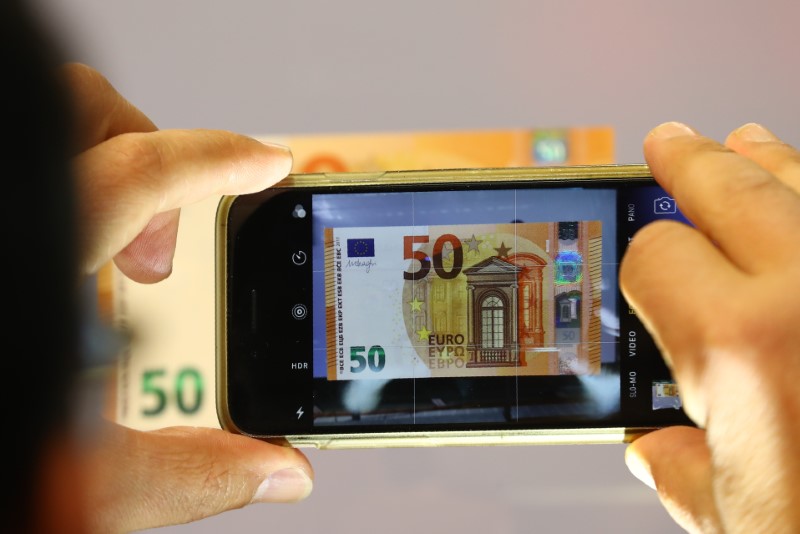By Dhara Ranasinghe and Tommy Wilkes
LONDON (Reuters) - Euro zone bond yields tumbled and the euro headed for its biggest daily loss versus the dollar in eight months on Thursday after the European Central Bank indicated it would not be raising interest rates through the summer of 2019.
The bank's unexpectedly dovish guidance on interest rates overshadowed, at least for the time being, its statement that it aimed to wrap up its stimulus program at the end of this year -- marking the biggest step in dismantling crisis-era stimulus -- quantitative easing.
The ECB now plans to reduce monthly asset purchases between October and December to 15 billion euros until the end of 2018 and then conclude the program, though ECB President Mario Draghi stressed that the governing council stood ready "to adjust all its instruments as appropriate".
However, investors seized on comments indicating that the end of QE would not be followed by rapid policy tightening, and that interest rates would stay at record lows at least through the summer of 2019.
Some market players now reckon rates may not rise even in the months immediately after next summer, noting that Draghi's tenure at the ECB would end in October 2019.
"Although we now know that QE is scheduled to end under Draghi’s watch, we think the ECB could wait a little longer before starting to raise interest rates," said David Zahn, head of European fixed income for Franklin Templeton.
"With Draghi's term of office due to expire at the end of October 2019, we feel the ECB is unlikely to start increasing interest rates until the new ECB president is firmly in place."
The single currency (EUR=EBS) is currently on track for its biggest one-day loss since October against the dollar, while it also fell one percent to the yen and half a percent to the Swiss franc (EURJPY=) (EURCHF=EBS).
Bond investors, meanwhile, drew comfort from the dovish interest rate outlook, with 10-year government bond yields in Germany, the euro zone benchmark, falling around four basis points to 0.44 percent (DE10YT=RR).
Analysts also noted that there were no changes to the ECB's plan to reinvest funds from maturing bonds, providing a layer of support for bonds markets even as the central bank winds down QE.
ECONOMIC GROWTH
Bond yields from Italy, the country seen as the most vulnerable to higher borrowing costs, also fell, with short-dated yields down 7 basis points at 0.89 percent (IT2YT=RR), having been 9 bps higher shortly before the ECB statement.
Italian 10-year yields were down around 2 bps at 2.80 percent (IT10YT=RR).
Draghi noted that volatility in Italy had ebbed in the past two weeks but revised down economic growth forecasts for the euro zone for 2018, while noting that inflation, after accounting for higher oil prices, remained muted
Karen Ward, chief market strategist at JPMorgan (NYSE:JPM) Asset Management, said the move to end QE by end-year as previously signaled was significant in light of the recent Italian mini-crisis that saw bond yields there soar to multi-year highs.
"Stepping back from QE will insulate the ECB from potential criticism that it is funding the fiscal largesse associated with certain populist policies."
But the ECB stance has surprised markets, partly because ECB policymakers such as chief economist Peter Praet, have in recent weeks indicated the central bank remained undeterred by events Italy or economic data indicating a slowdown in euro zone growth momentum.
"The hawks had been guiding for a June hike before the meeting and given the clear guidance the ECB gave today on interest rates, it had to be priced out," said Arne Petimezas, an analyst at AFS Group, an Amsterdam-based brokerage.
Money market pricing accordingly reflected a scaling ack of rate-hike bets over the next year.
Investors now price less than a 30 percent chance of a 10 basis point rate hike in June 2019, compared with a roughly 80 percent chance before the ECB announcement
On equity markets, an index of euro zone stocks - which benefit from a weaker euro - jumped 0.8 percent (STOXXE) to a 2 1/2 week high, having languished in negative territory before the announcement.
The biggest beneficiaries were interest-rate sensitive sectors such as autos (SXAP) which rose 1.8 percent, while shares in utilities rose 0.6 percent (SX86P).
Bank stocks, which tend to gain from higher interest rates, fell 0.5 percent on the day (SX7E) but JPM's Ward played down that move.
"If low interest rates support the health of the economy – not least via a weaker exchange rate – then that will help demand for lending and volume bank lending," she said.
For graphic on markets react to the end of ECB stimulus click: https://reut.rs/2JA5dy4
For graphic on investors scale back rate-hike bets click https://reut.rs/2JAVckm

For graphic on Euro set for biggest one-day fall in nearlt 8 months click https://reut.rs/2JOrjsH